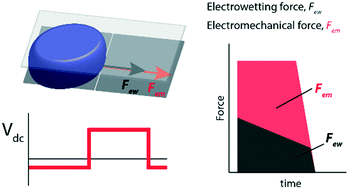Our official English website, www.x-mol.net, welcomes your
feedback! (Note: you will need to create a separate account there.)
Digital microfluidics using a differentially polarized interface (DPI) to enhance translational force†
Lab on a Chip ( IF 6.1 ) Pub Date : 2018-09-24 00:00:00 , DOI: 10.1039/c8lc00652k Md Enayet Razu 1, 2, 3, 4 , Jungkyu Kim 1, 2, 3, 4
Lab on a Chip ( IF 6.1 ) Pub Date : 2018-09-24 00:00:00 , DOI: 10.1039/c8lc00652k Md Enayet Razu 1, 2, 3, 4 , Jungkyu Kim 1, 2, 3, 4
Affiliation

|
Direct current (DC)-digital microfluidics (DMF) enables the manipulation of droplets to revolutionize medical diagnostics, environmental assays, and fundamental biology. However, DC-DMF requires high voltages to generate droplet motion, which often breaks dielectric layers at the micro/nano scale, causing electrolysis. To minimize these issues, oil-fillers are commonly used to decrease the voltage requirement by reducing the surface tension of the droplet to the surrounding fluid. However, these oil-fillers increase DC-DMF complexity and decrease versatility. In this study, by adapting a differentially polarized interface (DPI) to generate an effective electromechanical force, the voltage required to manipulate a droplet was reduced from 600 V to 85 V without an oil-filler or special dielectric materials. By analyzing the temporal profiles of the contact angles during droplet motion under this DPI condition, this study, for the first time, distinguished the contributions of electrowetting and electromechanical forces to the translational movement of droplets. Dominant contribution of electrowetting is observed at the initial stage of the droplet translation with 52.8% reduction in the advancing contact angle and 20% reduction in the receding contact angle. However, after saturation in the temporal change of the contact angle, the effect of electrowetting contribution gradually decreases and electromechanical forces predominate. DPI-based digital microfluidics reduces the overall cost and complexity of stand-alone DC-DMF platforms, enabling filler-less and low-voltage applications for manipulating a wide range of liquid samples.
中文翻译:

使用微分极化界面(DPI)来增强平移力的数字微流体†
直流(DC)数字微流控(DMF)能够对液滴进行操作,从而彻底改变医学诊断,环境测定和基础生物学的水平。但是,DC-DMF需要高电压才能产生液滴运动,这经常会破坏微米/纳米级的介电层,从而导致电解。为了最小化这些问题,通常使用注油器通过降低液滴对周围流体的表面张力来降低电压要求。但是,这些机油会增加DC-DMF的复杂性并降低多功能性。在这项研究中,通过采用差分极化界面(DPI)产生有效的机电力,在不使用油填充剂或特殊介电材料的情况下,操作液滴所需的电压从600 V降低至85V。通过分析在这种DPI条件下液滴运动过程中接触角的时间分布,这项研究首次区分了电润湿力和机电力对液滴平移运动的贡献。在液滴平移的初始阶段观察到电润湿的主要作用,前进接触角减小了52.8%,后退接触角减小了20%。然而,在接触角的时间变化饱和之后,电润湿作用的作用逐渐减小,并且机电力占主导地位。基于DPI的数字微流体技术降低了独立DC-DMF平台的总体成本和复杂性,从而实现了无填料和低压应用,可处理多种液体样品。
更新日期:2018-09-24
中文翻译:

使用微分极化界面(DPI)来增强平移力的数字微流体†
直流(DC)数字微流控(DMF)能够对液滴进行操作,从而彻底改变医学诊断,环境测定和基础生物学的水平。但是,DC-DMF需要高电压才能产生液滴运动,这经常会破坏微米/纳米级的介电层,从而导致电解。为了最小化这些问题,通常使用注油器通过降低液滴对周围流体的表面张力来降低电压要求。但是,这些机油会增加DC-DMF的复杂性并降低多功能性。在这项研究中,通过采用差分极化界面(DPI)产生有效的机电力,在不使用油填充剂或特殊介电材料的情况下,操作液滴所需的电压从600 V降低至85V。通过分析在这种DPI条件下液滴运动过程中接触角的时间分布,这项研究首次区分了电润湿力和机电力对液滴平移运动的贡献。在液滴平移的初始阶段观察到电润湿的主要作用,前进接触角减小了52.8%,后退接触角减小了20%。然而,在接触角的时间变化饱和之后,电润湿作用的作用逐渐减小,并且机电力占主导地位。基于DPI的数字微流体技术降低了独立DC-DMF平台的总体成本和复杂性,从而实现了无填料和低压应用,可处理多种液体样品。











































 京公网安备 11010802027423号
京公网安备 11010802027423号